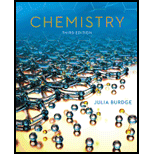
Concept explainers
Interpretation:
The reason for the fact that pure elements of group
Concept introduction:
Semiconductors are solids thathave conductivity lying between those of conductors and insulators.
The gap between the conduction band and the valence band is small, so electrons may jump from the valence band to the conduction band.
Conduction band: The conduction band is the band of electron orbitals that electrons can jump up into from the valence band when excited.
Valence band: The valence band is the band of electron orbitals that electrons can jump out of, moving into the conduction band when excited.
A dopant, also called a doping agent, is a trace impurity element that is inserted into a substance (in very low concentrations) to alter the electrical or optical properties of the substance.
Doping: Addition of dopant is doping.
n-Type semiconductor: A semiconductor that has been doped with electron donor atoms is called an n-type semiconductor.
p-Type semiconductor: A semiconductor that has been doped with electron acceptor atoms is called a p-type semiconductor.
Want to see the full answer?
Check out a sample textbook solution
Chapter 12 Solutions
Student Study Guide for Chemistry
- 4.) Carbon and graphite are allotropes of Carbon. Between graphite and diamond, which one is a good conductor of electricity and which one is not? Support answer with an explanation. (Limit answer to not more than 4 sentences)arrow_forwardIdentify 2 elements that would lead to an n-type semiconductor when added in trace amounts to silicon. Explain your response.arrow_forwardQUESTION: Manganese has a density of 7.33 g/cm^3 and unit cell edge length of 3.68 Å. Calculate the atomic radius (in Å) of manganese. *Please use the pictures provided (the formula and some values that can be substitutedarrow_forward
- Provide STEP by STEP details correct Explanation. Question : iron has a face centered cubic unit cell with a length of 608 pm along an edge. what is the density of iron in kg m-3 .arrow_forwardWhen you shine light of band gap energy or higher on asemiconductor and promote electrons from the valenceband to the conduction band, do you expect the conductivityof the semiconductor to (a) remain unchanged,(b) increase, or (c) decrease?arrow_forwardQUESTION: Calculate the number of unit cells in 0.5 cm^3 of iron solid sample if iron has an atomic diameter of 252 pm and crystallizes with a body-centered cubic structure. *Please use the pictures provided (the formula and some values that can be substituted)arrow_forward
- 2. Answer ALL parts a) - c). Sodium ([Ne] 3s¹3pº) forms a simple cubic (sc) primitive crystal structure, in which Na atoms are arranged at the corners of a cube. a) How many atoms are contained in the unit cell, and how many valence bands can be expected? b) Sketch the crystal orbitals at the special points ï'(0,0,0), X(1/2,1/2,0), and M(1/2,1/2,1/2), and hence draw the corresponding band structure along T-X-M-T. c) With the aid of a diagram, explain how the band structure would change if the cube was distorted into a rhombohedron by elongation along a body diagonal?arrow_forward5..Generally we add n-buLi to halogen for lithiation but sometimes addition of halogen to n-BuLi also observed,what is logic in reverse additionarrow_forwardGuided Question:(Pls Answers all this Question.) 1. In crystal growth, what is the purpose of the seed crystal? 2. What is the importance of leaving the crystal growth undisturbed? How are imperfections formed in crystal growth? Cite some examples. 3. Compare and contrast the two types of close-packing in solids? 4. Why is there % error in part II? What could be the reason for such error? 5. By understanding the structure of crystals molecularly, what is its relation to the strength of materials? 6. Use the internet to search three (3) examples of metals which have HCP, FCC and BCC structures. Relate the structure to the characteristic properties of each metal. Please indicate the condition the given structures are observed.arrow_forward
- Which is/are true of ceramics? Check the right answers a) They are composed of anions and cations. b) To have a stable structure, the anions surrounding a cation must all be in contact with that cation. c) They can have silica. d) Porosities can improve their mechanical properties. e) none of the abovearrow_forward!onlyroundoffinfinalanswer(2decimalplaces)Lead, Pb, is used in solders and as radiation shield. It adopts the face centered cubic unit structure with each of the atom having a diameter of 0.37 nanometer. Find the theoretical density of lead if the molecular weight of this metal is 159.7 g/mol.sdasarrow_forwardAnswer all please !! Density Calculation 3. Iron has a BCC crystal structure, an atomic radius of 0.124 nm, and an atomic weight of 55.85 g/mol. Compute and compare its theoretical density with the experimental value, 7.87 g/cm3.4. Zirconium has an HCP crystal structure and a density of 6.51 g/cm3. (a) What is the volume of its unit cell in cubic meters? (b) If the c/a ratio is 1.593, compute the values of c and a.arrow_forward
 Chemistry for Engineering StudentsChemistryISBN:9781285199023Author:Lawrence S. Brown, Tom HolmePublisher:Cengage Learning
Chemistry for Engineering StudentsChemistryISBN:9781285199023Author:Lawrence S. Brown, Tom HolmePublisher:Cengage Learning Chemistry for Engineering StudentsChemistryISBN:9781337398909Author:Lawrence S. Brown, Tom HolmePublisher:Cengage Learning
Chemistry for Engineering StudentsChemistryISBN:9781337398909Author:Lawrence S. Brown, Tom HolmePublisher:Cengage Learning

